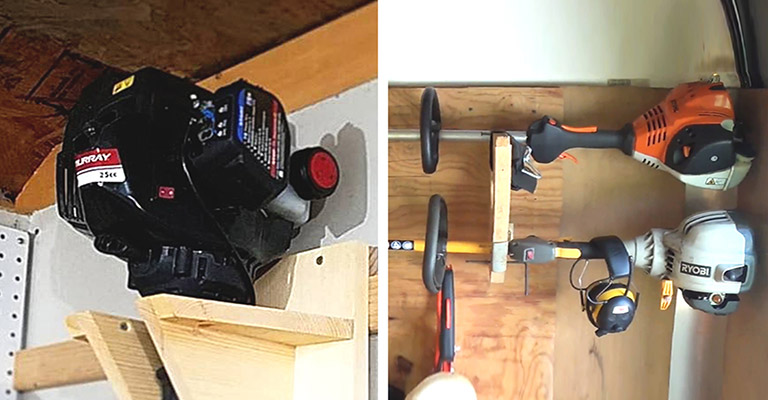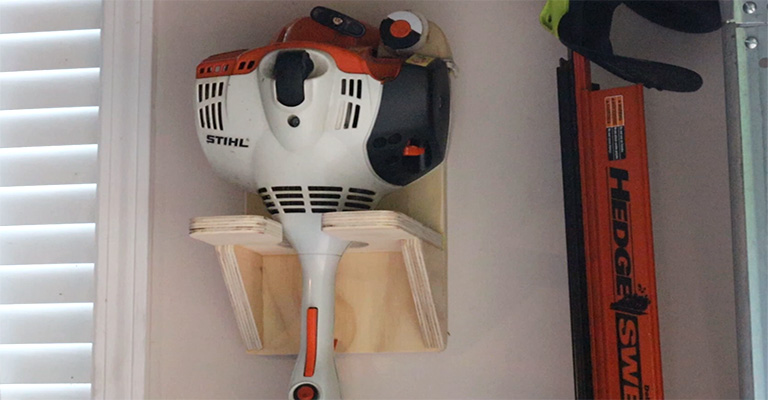How To Store Weed Eater Safely?
A weed eater is a machine used to cut and trim the grass and weeds. It has a long handle and a cutting head that rotates to cut the weeds. There are various ways to store this machine, and you should choose the one which best suits your needs.
You can choose the storage place according to whether you use your weed eater often or not so often. If used often, it should be stored in an accessible place such as in a garage or shed so that you can easily use it when needed.
If not, these machines should be kept in a storage area that is difficult to access, such as under basement steps or in a garden shed. Now, when it comes to long-term storage, there are a couple of things you will need to know about.
There are two main options when storing your weed eater—hanging it on the wall or laying it flat on the floor. Most people choose to hang their weed eater on the wall because it takes up less space and prevents dust from accumulating.
However, some people find that their weed eater’s cord is always in the way when they hang it up this way.
Storing Weed Eater
Weed eaters are some of the most popular lawn equipment for homeowners. However, they can be a bit cumbersome to store. This is because they are often bulky and easy to misplace.
There are two main ways to store weed eaters outside of your home: hanging them on a wall or laying it flat on the floor of your garage or shed. When storing your weed eater, there are two main options.
Hanging it on the wall or laying it flat on the floor. Most people choose to hang their weed eater on the wall because it takes up less space and prevents dust from accumulating. However, some people find that their weed eater’s cord is always in the way when they hang it up this way.
Hanging weed eaters on the wall is the most common way people decide to keep their lawn equipment outside their homes – but that doesn’t mean it’s the best way! Hanging them on a wall means you have more space in your garage or shed.
It is important to store your weed eater for safety reasons properly. For example, hanging the weed eater up on a hook will keep it out of the way and prevent it from gathering any dirt or grime that may be on the floor.
How To Store Your Weed Eater For The Winter
To ensure your weed eater is working at peak efficiency this winter, you should follow a few additional steps.
The gasoline in your weed eater will deteriorate very quickly over the winter, so you should not leave any in there. The best way to conserve as much as possible is to empty the gas tank into a smaller gas can. You can then store it, use it to start a bonfire, or enjoy it for whatever you need!
The carburetor still contains gas that must be drained. This will ensure there is no gas left in the weed eater, and we can move on. All you have to do is start the engine and let it run until it runs out.
Cleanliness and maintenance are the last two. The best way to get rid of the grime built up over the summer is to use a brake parts cleaner to get into all of the nooks and crannies. Take off any plastic covering and thoroughly clean the brakes. It’s that simple. Your weed eater is now ready to store away for the winter.
What Fuel Stabilizer Should I Use With My Weed Eater In Winter?
You should add a fuel stabilizer to your weed eater’s tank if you plan to leave it for the winter. Manufacturers, however, are increasingly recommending that customers drain their fuel tanks before storing them for an extended period.
Storing Electric Weed Eater
There is no difference between electric and gas-powered weed eater storage, except those electric weed eaters, use batteries rather than gasoline.
Taking the battery out before storing the weed eater is the only thing you must do. When you leave a battery plugged in, it will degrade over time, just as it does with any other electronic device.
Storing Gas-Powered Weed Eater
We’ve already mentioned that you should hang your weed eater on the wall; this is primarily for safety and to keep your workshop tidy! But, despite that, it’s best to hang it for a good reason, not only out of vanity.
A gasoline-powered weed eater runs on, you guessed it, gasoline. There is an engine, carburetor, and air filter, so you should not leave your weed eater on its side as this could flood the engine or damage it.
The best way to keep your weed eater safe and to work properly is to hang it by the engine on the wall.
Vertical vs. Horizontal Storage
Depending on how the gas string trimmer is stored, it can be vertical or horizontal. The use of commercial or DIY wall hangers can maximize space by allowing you to store things vertically.

Hanging your trimmer is not the only factor to consider when storing it. Don’t just store it away and walk away. You need to know a few things about storing it, regardless of whether it’s for winter storage or just between trimming sessions.
Should I Hang A Weed Eater With The Engine Up Or Down?
Professionals and homeowners alike hold strong opinions on this issue. Since I had the Stihl Kombi system mounted vertically, I did it both with the engine up and down. Either way has advantages and disadvantages.
String trimmers are typically hung with the engine facing up for vertical storage. Less supported weight is hung freely to prevent fuel leaks and prevent trimmer malfunctions.
Having said that, I have never encountered an issue with my car hanging with its engine down. It has happened both ways, and I have never experienced leaks. However, it’s generally accepted that the trimmer should still be hung with the engine up.
Can You Store A String Trimmer Vertically?
Vertical storage is possible for gas string trimmers. Most manufacturers recommend vertical storage, including Stihl. Both homeowners and lawn care professionals organize their tools by hanging trimmers on walls in sheds or inside portable enclosed trailers.

You can purchase inexpensive wall hangers for string trimmers if you have an unfinished garage or shed. The interior walls can be easily DIYed if the studs are visible (i.e., the walls are unfinished).
Here Are Some Storage Solutions:
You will need a place to keep your weed eater when you own one.
Shelving Racks
The storage of weed whackers and other tools in your garage or shed can also be handled with shelves. Using some plywood and creating indents or holes in them, you can create a custom slotted rack or shelves for your weed trimmer and all your gardening tools over the winter.
You may choose to purchase pre-made shelves from your local hardware store if you are not inclined to do the job yourself.
Brackets and Hooks
Hang up your weed eater in your garage or other storage areas away from the ground where it can easily get trampled on and damaged. You might need the best roof ladders for this project.
You can put quite a bit of space under a four-stroke weed eater! Of course, you need to keep your weed eater safe since they are expensive items. With a simple plywood bracket installed on the wall, you can hang your weed whacker in your garage or any other room you desire.
Final Words
Selecting a suitable storage location for your gas weed eater is crucial to prolong its lifespan and maintain optimal performance. Before storing your equipment, it’s essential to take a few extra steps to ensure it’s in the best condition for its next use. Always refer to the manufacturer’s instructions for specific advice on performing maintenance, such as checking the spark plug and ensuring the fuel tank is properly handled to prevent leaks. Additionally, taking safety precautions to avoid exposure to extreme temperatures can prevent damage to the weed eater’s internal components.
For those with attachments, like leaf blowers or extra trimmer lines, it’s advisable to store attachments separately. This not only helps in organizing your tools better but also prevents any accidental damage from occurring. After clearing the weed eater of any grass clippings, ensure that the area around the spark plug is clean and the fuel tank is secured as per safety guidelines. Properly storing your gas weed eater, along with its attachments, not only safeguards the equipment from unnecessary wear but also ensures that it is ready to perform efficiently the next time it is needed. Remember, a little effort in storage and maintenance can significantly extend the life and effectiveness of your gardening tools.




